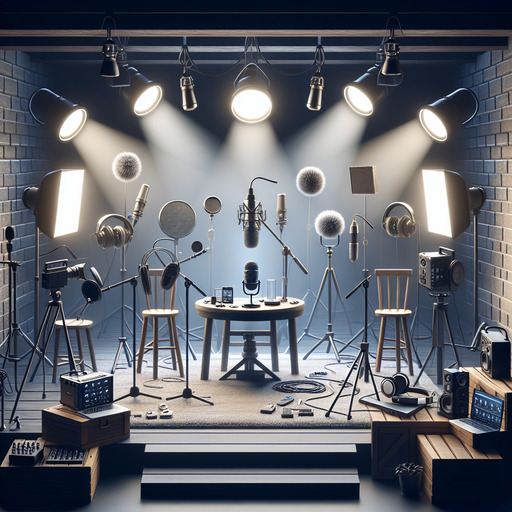
-
Table of Contents
Ready to elevate your video podcasting game? Discover the ultimate guide to creating a professional studio setup! Learn more here.
Introduction
Creating a studio setup for video podcasting involves several key steps to ensure high-quality production. First, choose a quiet, dedicated space with good acoustics to minimize background noise. Invest in quality equipment, including a high-definition camera, reliable microphones, and proper lighting to enhance video and audio clarity. Set up a visually appealing background that reflects your podcast’s theme, and consider soundproofing materials to improve audio quality. Ensure you have a powerful computer with video editing software to handle post-production tasks. Finally, test your setup thoroughly before recording to troubleshoot any technical issues and make necessary adjustments for a professional finish.
How to Create a Studio Setup for Video Podcasting: Essential Tips and Equipment for High-Quality Podcast Video Production
Creating a studio setup for video podcasting involves a blend of strategic planning, technical know-how, and a keen eye for detail. To achieve high-quality podcast video production, it is essential to consider several key factors, including the choice of equipment, the arrangement of the studio space, and the optimization of audio and visual elements. By following these essential tips, you can ensure that your video podcasting setup is both professional and effective.
First and foremost, selecting the right camera is crucial for capturing clear and sharp video. While there are numerous options available, it is advisable to invest in a DSLR or mirrorless camera with high resolution and good low-light performance. These cameras offer superior image quality and flexibility compared to standard webcams. Additionally, ensure that your camera has a clean HDMI output, which allows for a direct feed to your recording or streaming software without any on-screen display elements.
Equally important is the choice of lenses. A prime lens with a wide aperture, such as f/1.8 or f/2.8, can create a pleasing depth of field, making the subject stand out against a softly blurred background. This not only enhances the visual appeal but also adds a professional touch to your video podcast.
Lighting is another critical component that can significantly impact the quality of your video. Natural light is ideal, but it is not always reliable or consistent. Therefore, investing in artificial lighting solutions, such as softbox lights or LED panels, is essential. Positioning these lights at a 45-degree angle to the subject can help eliminate harsh shadows and create a well-lit, flattering appearance. Additionally, using a ring light can provide even, diffused lighting that is particularly effective for close-up shots.
Audio quality is just as important as video quality in a video podcast. A high-quality microphone is indispensable for capturing clear and crisp audio. Condenser microphones are a popular choice due to their sensitivity and ability to capture a wide range of frequencies. However, dynamic microphones are also a viable option, especially in environments with background noise. To further enhance audio quality, consider using a pop filter to reduce plosive sounds and a shock mount to minimize vibrations.
The studio environment itself plays a significant role in the overall production quality. Choose a quiet, controlled space where you can manage external noise and interruptions. Acoustic treatment, such as foam panels or bass traps, can help reduce echo and improve sound clarity. Additionally, consider the background of your video frame. A clean, uncluttered backdrop or a branded set design can add a professional touch and keep the focus on the subject.
In terms of software, reliable recording and editing tools are essential. Programs like OBS Studio for recording and Adobe Premiere Pro for editing offer a range of features that can enhance your production quality. These tools allow you to fine-tune audio levels, color-correct video footage, and add graphics or text overlays, ensuring a polished final product.
Finally, connectivity and power management should not be overlooked. Ensure that all your equipment is properly connected and that you have a stable power supply to avoid interruptions during recording. Using a UPS (Uninterruptible Power Supply) can provide an added layer of security against power outages.
In conclusion, creating a studio setup for video podcasting requires careful consideration of various elements, from camera and lighting to audio and environment. By investing in high-quality equipment and optimizing your studio space, you can produce professional-grade video podcasts that engage and captivate your audience.
Q&A
1. **What equipment is essential for a video podcast studio setup?**
– **Camera**: A high-quality DSLR or mirrorless camera.
– **Microphone**: Condenser or dynamic microphones with pop filters.
– **Lighting**: Softbox lights or ring lights for even lighting.
– **Tripod**: Stable tripod for camera placement.
– **Audio Interface**: For connecting microphones to your computer.
– **Headphones**: For monitoring audio quality.
– **Computer**: With sufficient processing power for editing.
– **Editing Software**: Such as Adobe Premiere Pro or Final Cut Pro.
– **Backdrop**: Clean and professional background or green screen.
– **Cables and Accessories**: XLR cables, USB cables, and cable management tools.